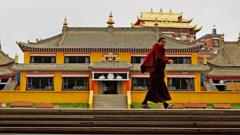In a visit to the Kirti monastery in Aba, Sichuan province, the BBC reports on the ongoing struggle for Tibetan autonomy under China's strict regime, as tensions rise with the Dalai Lama's succession plan amidst fears of cultural erasure and heavy surveillance.
Tibetan Resistance Prevails Amidst Tensions with China as Dalai Lama's Future Uncertain

Tibetan Resistance Prevails Amidst Tensions with China as Dalai Lama's Future Uncertain
As the Dalai Lama celebrates his 90th birthday, the Tibetan community faces mounting oppression in China, while concerns grow over the future of Tibetan Buddhism and identity.
In the heart of Tibetan resistance, the Kirti monastery in Aba, Sichuan province, illustrates the ongoing struggle Tibetans face under Chinese rule. As the Dalai Lama reaches the significant milestone of turning 90, the atmosphere in this remote region remains fraught with anxiety and oppression.
During a recent undercover visit, BBC correspondent Xiqing Wang reported interactions with monks in the monastery, who openly expressed their discontent with the Chinese government. Observing ominous surveillance measures, including a police station at the monastery’s gates and multiple cameras monitoring the area, it becomes evident that even brief discussions about their reality could incur severe repercussions.
The Dalai Lama's longstanding position as a spiritual leader has drawn the ire of Beijing, which hides under the banner of "unity" while labeling him a separatist. This fear has led to a crackdown on any signs of allegiance to him, with many Tibetans apprehensive about openly celebrating his birthday or revealing their beliefs.
Aba has historically played a significant role in the Tibetan resistance, notably during the 2008 uprisings when images of the Dalai Lama sparked violent confrontations. The repercussions have been devastating—over 150 self-immolations have occurred, underlining the extreme lengths Tibetans will go to assert their rights.
While the Dalai Lama's latest succession announcement has sparked a range of reactions among Tibetans, those within their homeland are largely suppressed from sharing their opinions due to strict censorship imposed by the Chinese government. As exiled Tibetans gather in India to honor him, echoes of uncertainty swirl about who will lead their community posthumously.
The looming prospect of an official succession process led by the Chinese government raises concerns about a manufactured Dalai Lama that may serve Beijing's propaganda needs while bending Buddhism to conform to state ideals. Experts warn that tighter educational regulations and cultural restrictions threaten the essence of Tibetan identity.
As modernization sweeps through the region, the juxtaposition of heavy surveillance and attempts to promote tourism unfold against the backdrop of centuries-old traditions. The Tibetan community remains resilient; however, the challenge to protect their identity amid ongoing repression intensifies as they prepare for an uncertain future without their revered leader.
Concerns extend beyond individual freedom and faith, as the very fabric of Tibetan society grapples with possible extinction under a regime eager to reshape its culture. The Dalai Lama’s identity as a potent symbol of resistance, and the authenticity of his successors will play crucial roles in the continuing fight for Tibetan autonomy.




















